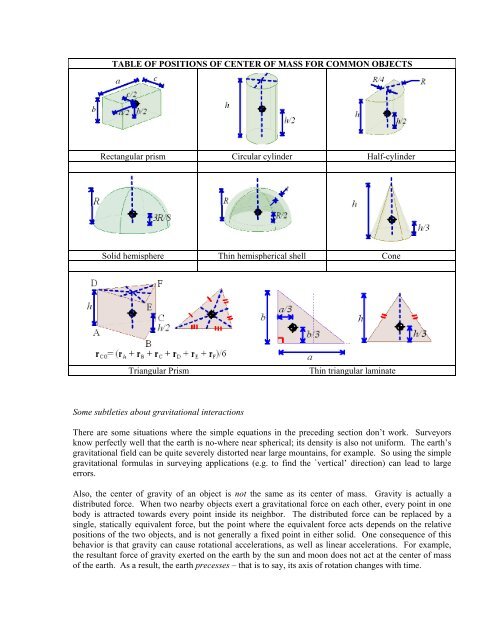Chapter 2 Review of Forces and Moments - Brown University
Chapter 2 Review of Forces and Moments - Brown University
Chapter 2 Review of Forces and Moments - Brown University
You also want an ePaper? Increase the reach of your titles
YUMPU automatically turns print PDFs into web optimized ePapers that Google loves.
TABLE OF POSITIONS OF CENTER OF MASS FOR COMMON OBJECTS<br />
Rectangular prism Circular cylinder Half-cylinder<br />
Solid hemisphere Thin hemispherical shell Cone<br />
Triangular Prism<br />
Thin triangular laminate<br />
Some subtleties about gravitational interactions<br />
There are some situations where the simple equations in the preceding section don’t work. Surveyors<br />
know perfectly well that the earth is no-where near spherical; its density is also not uniform. The earth’s<br />
gravitational field can be quite severely distorted near large mountains, for example. So using the simple<br />
gravitational formulas in surveying applications (e.g. to find the `vertical’ direction) can lead to large<br />
errors.<br />
Also, the center <strong>of</strong> gravity <strong>of</strong> an object is not the same as its center <strong>of</strong> mass. Gravity is actually a<br />
distributed force. When two nearby objects exert a gravitational force on each other, every point in one<br />
body is attracted towards every point inside its neighbor. The distributed force can be replaced by a<br />
single, statically equivalent force, but the point where the equivalent force acts depends on the relative<br />
positions <strong>of</strong> the two objects, <strong>and</strong> is not generally a fixed point in either solid. One consequence <strong>of</strong> this<br />
behavior is that gravity can cause rotational accelerations, as well as linear accelerations. For example,<br />
the resultant force <strong>of</strong> gravity exerted on the earth by the sun <strong>and</strong> moon does not act at the center <strong>of</strong> mass<br />
<strong>of</strong> the earth. As a result, the earth precesses – that is to say, its axis <strong>of</strong> rotation changes with time.
















